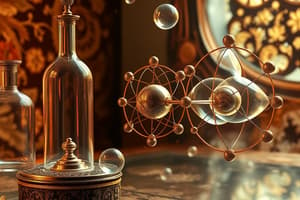Podcast
Questions and Answers
J.J. Thomson's model of the atom is called the "plum pudding" model.
J.J. Thomson's model of the atom is called the "plum pudding" model.
True (A)
John Dalton proposed that atoms can be divided into smaller particles.
John Dalton proposed that atoms can be divided into smaller particles.
False (B)
Rutherford's gold foil experiment provided evidence for the existence of the nucleus.
Rutherford's gold foil experiment provided evidence for the existence of the nucleus.
True (A)
The quantum mechanical model describes the exact location of electrons around the nucleus.
The quantum mechanical model describes the exact location of electrons around the nucleus.
Niels Bohr proposed that electrons could only exist in specific energy levels, called orbits.
Niels Bohr proposed that electrons could only exist in specific energy levels, called orbits.
The "plum pudding" model was the first to propose the existence of a nucleus.
The "plum pudding" model was the first to propose the existence of a nucleus.
Cathode rays are made up of negatively charged particles.
Cathode rays are made up of negatively charged particles.
The quantum mechanical model is the simplest model of the atom.
The quantum mechanical model is the simplest model of the atom.
All alpha particles were deflected at large angles during Rutherford's experiment.
All alpha particles were deflected at large angles during Rutherford's experiment.
John Dalton's theory stated that elements always combine in simple whole-number ratios to form chemical compounds.
John Dalton's theory stated that elements always combine in simple whole-number ratios to form chemical compounds.
Flashcards
John Dalton's Atomic Theory
John Dalton's Atomic Theory
All matter is composed of indivisible atoms, each with distinct weights.
Simple Whole-Number Ratios
Simple Whole-Number Ratios
Dalton's theory states elements combine in simple whole-number ratios in compounds.
J.J. Thomson's Electron Discovery
J.J. Thomson's Electron Discovery
Thomson discovered the electron, a negatively charged subatomic particle, in 1897.
Plum Pudding Model
Plum Pudding Model
Signup and view all the flashcards
Rutherford's Nuclear Model
Rutherford's Nuclear Model
Signup and view all the flashcards
Deflection of Alpha Particles
Deflection of Alpha Particles
Signup and view all the flashcards
Niels Bohr's Energy Levels
Niels Bohr's Energy Levels
Signup and view all the flashcards
Quantum Leap
Quantum Leap
Signup and view all the flashcards
Quantum Mechanical Model
Quantum Mechanical Model
Signup and view all the flashcards
Orbitals
Orbitals
Signup and view all the flashcards
Study Notes
John Dalton's Atomic Theory
- John Dalton proposed the Atomic Theory in 1803.
- His theory stated that all matter is composed of atoms, which are indivisible and indestructible particles.
- Dalton's theory explained why elements always combine in simple whole-number ratios to form chemical compounds.
- Each element has its own unique type of atom with a specific weight.
J.J. Thomson's "Plum Pudding" Model
- In 1897, J.J. Thomson discovered the electron.
- He used magnets and electric plates to deflect cathode rays, which are made up of negatively charged particles.
- The electron is a subatomic particle that is over 1000 times lighter than the smallest atom, hydrogen.
- Thomson's model proposed a positively charged sphere with negatively charged electrons embedded in it, resembling plum pudding.
Ernest Rutherford's Nuclear Model
- In 1909, Rutherford and his colleagues bombarded a thin gold foil with alpha particles.
- Most alpha particles passed straight through, but some were deflected at large angles.
- This experimental evidence suggested that the atom has a small, dense, positively charged center called the nucleus, which contains most of the atom's mass.
- Rutherford's model proposed a mostly empty space, with electrons orbiting the nucleus.
Niels Bohr's Planetary Model
- Bohr revised Rutherford's model by proposing that electrons orbit the nucleus in fixed energy levels or orbits, similar to the planets orbiting the sun.
- The electrons are at fixed distances from the nucleus, with the lowest energy level closest to the nucleus.
- Electrons can jump between energy levels by gaining or losing a discrete amount of energy, called a quantum of energy, which explains the concept of a quantum leap.
- The Bohr model explained why each element has specific chemical properties due to the number of electrons available for reactions, which are the valence electrons in the outermost orbits.
Quantum Mechanical Model
- The quantum mechanical model is the most recent and accurate model of the atom.
- It's based on the principles of quantum mechanics, which proposes that electrons behave as both particles and waves.
- The quantum mechanical model describes the probability of finding electrons in specific regions around the nucleus called orbitals.
- It's a more complex model than Bohr's, but it's able to explain the behavior of atoms in more detail.
Studying That Suits You
Use AI to generate personalized quizzes and flashcards to suit your learning preferences.




